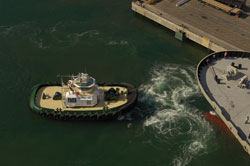Until now, there have been two significant obstacles to building an efficient electric boat without sacrificing power or performance: the size and weight of traditional lead-acid batteries and attitudes.
Corvus Energy's new Titan series battery modules have removed the former, and Ron Burchett, the company's commercial marine manager, has a long list of reasons that might go a long way toward mitigating the latter.
Forget about being green, forget about your carbon footprint, carbon credits any of that, he said — switch to the lithium-ion batteries his company is manufacturing and your operating and maintenance costs will drop dramatically.
"Nobody's really done it before, because it's a fear of the unknown," Burchett said. "People say, 'We've always done it this way; why should we change?'"
The batteries made by the company based in Richmond, British Columbia, come in 6.2 kWh units and can be scaled to megawatt sizes — enough for large vessels, from yachts to tugs to ferries, to shift from diesel propulsion to hybrid or all-electric systems that provide comparable power for significantly less consumption of fuel. They can also be used to power things like winch motors, greatly reducing the fuel consumption vessel-wide.
 |
|
Lithium-ion battery packs from Corvus Energy. (Photo courtesy Corvus Energy) |
"Even if you don't use them for propulsion, you can use them just for the house battery sets, what we call the house supply," Burchett said. "It's efficient. You don't need a generator — instead, you install a battery pack."
Eliminating the gensets represents a significant savings in capital costs. Since the batteries can be recharged with shore power, there are also substantial savings in fuel costs. House-supply battery packs are sized to operate for eight to 10 hours, enabling them to run all night — and quietly, without a generator.
"You're back to how a little boat operates," Burchett said, "with no genset. Even just with that, you can cut your carbon footprint down exponentially."
The batteries aren't cheap, but the investment can be recouped in as little as five years — and they're guaranteed for 20 years.
Dow Kokam makes the batteries' nickel-manganese-cobalt-based cells using a proprietary formula. Corvus packages the cells in battery packs and makes the power management system that controls them.
 |
|
Foss Maritime's tug Campbell Foss, shown doing ship assist work in Long Beach, Calif., is to be converted to a hybrid tug using lithium-ion battery packs from Corvus Energy like the ones in the image above. The new batteries will weigh about one-fourth as much as the lead batteries in a sister vessel, Foss's groundbreaking hybrid tug Carolyn Dorothy. Campbell Foss is due to be back in service as a hybrid in late 2011. (Photo courtesy Foss Maritime Co.) |
"That's the whole trick," Burchett said. "A computer board monitors the charge and discharge of each cell." The maintenance-free batteries also last up to 10 times longer than lead-acid batteries, and they're 99 percent recyclable — only the plastic coating of the cells cannot be reused.
Costs decrease even further when you use the batteries for propulsion, either as part of a hybrid system or a full electric boat. In a hybrid system, the vessel can run on batteries when it doesn't need the full engine power, saving as much as 60 percent of the fuel bill.
A single working vessel might use 200,000 fewer gallons of diesel each year, resulting in significant savings at the pump.
In 2009, Seattle-based Foss Maritime built the world's first hybrid tug. The 78-foot Carolyn Dorothy can cruise on battery power or engine power, or on a combination to maximize power and efficiency. The harbor tug is a near-ideal application for the technology. Viability studies showed the company's other tugs were using full power only 7 percent of the time, and that they ran at less than 20 percent power about two-thirds of the time.
Now Foss is retrofitting a second tug with hybrid systems. This time around, they're using the Corvus battery pack rather than the lead-acid batteries used on Carolyn Dorothy. The new batteries are about a quarter of the weight of the lead-acid batteries, and "quite a lot smaller," said Susan Hayman, vice president of environmental and government affairs for Foss.
Campbell Foss will retain her existing Caterpillar 3512 engines (5,080 hp), plus two auxiliary generators that can be used for propulsion.
"We're doing a few tweaks to improve the consumption a bit, but she'll be very similar to the Carolyn Dorothy," Hayman said. "It was all theoretical with the first one. Now that we've learned from it, we're going to incorporate what we learned into the new one."
The computer assigns power options to modes for different purposes — for example, transit mode or assist mode. Defining additional modes based on real-world usage allows the operator to use only the power that's needed, and no more.
"We're looking at more options for modes," she said. "I think that will improve our fuel efficiency even better."
Campbell Foss is scheduled to go to the company's Rainier, Ore., shipyard in July, and should be back in the water in Southern California by the end of the year.
"You have to look at the economics, not just the environment," Hayward said. "For us, we're driven primarily by the environmental reasons, but a lot of companies want to look at the cost side. Hybrid really allows you to reduce all forms of emissions. We're getting fuel savings and very large maintenance savings because the main engines are off 50 percent of the time. We really think it's the future."
Corvus is banking on it. The company is staffing up amidst a flurry of media attention, successes and awards. In March the company announced it would be providing batteries for the Canadian Space Agency's prototype lunar rover.
"It's a whole new day," Burchett said.
